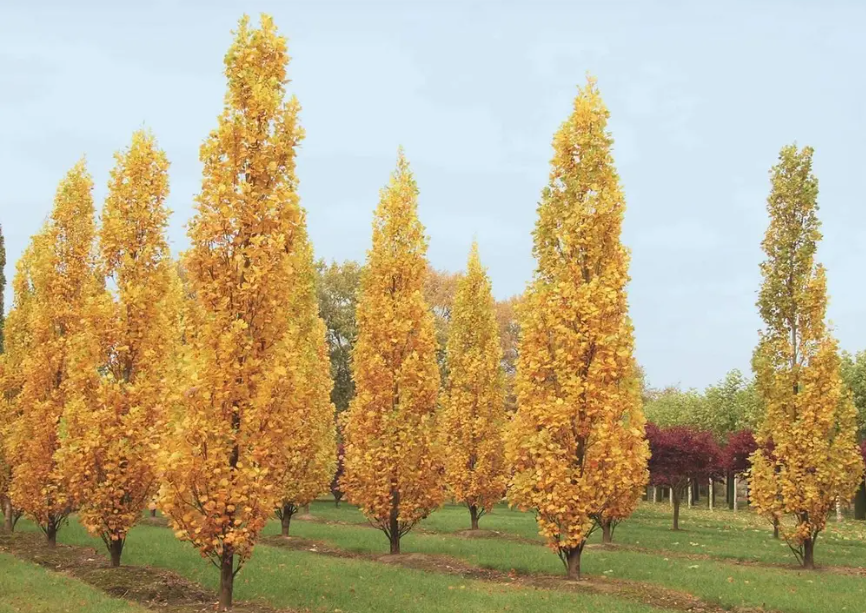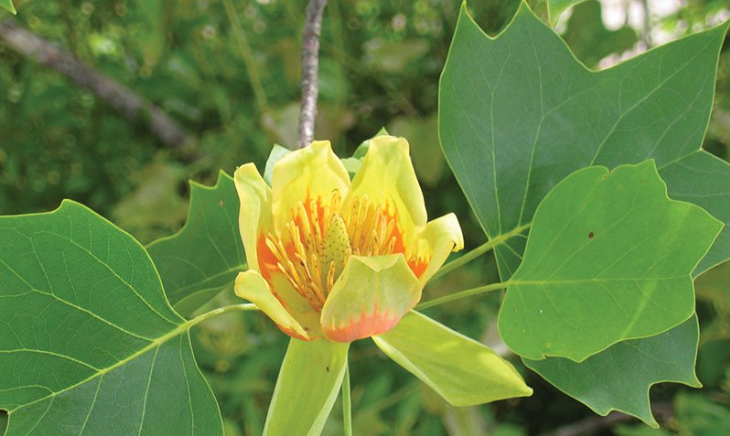
The tulip tree (Liriodendron tulipifera) is a large deciduous tree native to eastern North America, belonging to the magnolia family. It is also known as the tulip poplar, American tulip tree, tulipwood, tuliptree, tulip poplar, whitewood, fiddletree, and yellow-poplar. This tree is the North American representative of the two-species genus Liriodendron, and it is the tallest eastern hardwood.
They are found from southern Ontario and Illinois eastward to southwestern Massachusetts and Rhode Island, and south to central Florida and Louisiana. The trees are most common in the Appalachian Mountains, but they can also be found in the Piedmont and Coastal Plain regions.
The tulip tree can also be found from southern New England and New York, west to southern Michigan and northern Ohio, and south to Louisiana and northern Florida. It is also found in parts of eastern Canada.
Tulip tree is one of the tallest eastern hardwoods, with mature heights ranging from 60 to 90 feet and a spread of 30 to 40 feet. It is fast-growing, especially when young, and can reach a mature height in a relatively short period. It can even grow much taller under favorable conditions. The tree has a pyramidal to broad conical habit, with trunks of mature trees reaching 4-6 feet (1.2-1.8 meters) in diameter. The tallest known tulip tree, located in the Great Smoky Mountains National Park, stands at an impressive 191.9 feet (58.49 meters).

The leaves of the tulip tree (Liriodendron tulipifera) are large, measuring 3 to 8 inches (8 to 20 centimeters) in length and width. The leaves are four-lobed, with the lobes separated by deep sinuses. The leaf margin is smooth, with no teeth or serrations. In the spring, the leaves emerge a bright green color, and they turn a golden yellow in the fall before dropping. The leaves are arranged alternately along the twigs, and they have long petioles that allow them to flutter in the breeze.
Initially, the bark is smooth and dark green on young trees. As the tree ages, it develops a unique pattern of deep furrows and ridges, which become more pronounced with age. The furrows are lined with white. Even when the bark is old and furrowed, it retains a smooth look. The color of the bark changes from a light gray/brown when the tree is young to a darker gray or brown as it ages.
The flowers have a unique structure, with petals that are stiff and resemble a tulip, but with a more upright and open shape. These flowers are yellowish-green with a touch of orange on the outside, and they bloom in late spring, typically after the leaves have fully developed. The flowers are quite large, measuring about 1 to 4 inches (3 to 10 cm) in diameter. They are quite beautiful but can often go unnoticed on large trees due to their high position in the tree’s canopy.
The root system of a mature tulip tree is typically just as deep and wide as the tree is tall and wide, respectively. This means that the roots can extend 100 feet deep and 30 feet wide.
Tulip trees can live up to 500 years or more when planted in optimal conditions. When young, and can grow more than 25 inches a year. However, as they age, their growth rate slows down. The trees can reach heights of 80 to 100 feet on average, with some specimens reaching nearly 200 feet under optimal conditions.
The lifespan of a tulip tree can vary depending on several factors, including the growing conditions, climate, and whether it is planted in its native habitat or in a cultivated setting. In general, tulip trees thrive in moist, well-drained soil with a pH of 3.7 to 6.5 and prefer full sun to partial shade. It is hardy in USDA hardiness zones 4 through 9.
Cultivation
- Planting: The easiest way for a gardener to acquire a new tulip poplar is to purchase a young tree from a nursery or garden center. If you have access to a mature tulip tree, try collecting a dry seedhead in the fall or winter and start your own young tree from seed. Simply directly sow a few seeds where you want a tulip tree to grow and protect them with a critter cage so the squirrels won’t dig them up before they sprout.
- Location: Plant in a spacious, sunny area at least 60 feet away from structures. Tulip trees thrive in full sun, requiring 6-8 hours of direct sunlight daily. If you have a large yard, plant a tulip tree as a central focal point, intersperse it with some other hardwood trees, or plant it at a back edge where a large tree might not be intrusive into your other landscaping projects.
- Soil: Tulip trees prefer moist, well-drained soil. They are adaptable to a variety of soil types but do best in slightly acidic to neutral soil.
- Watering: Keep the soil around the tulip tree consistently moist, especially during the first year after planting. Once established, tulip trees are relatively drought-tolerant.
- Pruning: Prune out dead and weak growth in late winter to early spring and do a thorough thinning every few years.
- Mulching: To enhance the soil’s quality and support the tree’s health, consider mulching around the base of the tree. This helps retain moisture and maintain optimal soil conditions.
- Pests and Diseases: The trees are generally resistant to pests and diseases. However, they can be susceptible to aphids, which may cause an unnatural yellowing of leaves. In a tree as large as a mature tulip tree, it’s quite possible that you would never notice mildew unless the leaves drop prematurely and you see mildew spots on the fallen leaves.
- Overwintering: Applying a layer of mulch around the base of the tree during the late fall or early winter not only helps to retain moisture but also provides additional insulation against the cold.